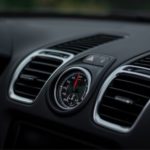Quick Navigation
If you feel something strange when pressing brakes, you may be concerned. It is often a sign that you have air in your brake lines.
Brake lines are parts of your braking system that contains and distribute brake fluid.

They comprise a hydraulic system that employs pressure via the brake fluid to activate the brakes.
Air could be the main culprit whenever you have problems with your brakes because it reduces the air pressure on your brake system, making it less operational and less effective.
Your brake system then suffers in the long run when air enters the brake lines.
Air In Brake Lines: Symptoms And Problems It Can Cause
Air in brake lines is an issue that you must take care of since it is a safety concern.
You must be vigilant when you encounter the signs and symptoms and contact a reputable mechanic to fix them. Some of the signs of air in brake lines are the following:
Spongy Feeling
When you are driving, you find out that it has an unusual feeling of being soft, mushy, squishy, or spongy when pressing down the brake pedals.
It is an indication that there is air in your brake lines. It is more likely the same as you step on a squishy ball.
The air inside the brake lines creates pressure making it spongy. And this you should not ignore in the long run because it may get worse over time.
Inefficient Brakes
Once you have felt that the brakes behave strangely, you may have noticed that you are not slowing down, or it takes time for the brakes to do their work.
Because of the air inside your brake system, all of its components will have reduced efficiency, leading to ineffective stops.
Brake Pedal Goes To The Floor
If your brake pedal goes beyond the average distance or when it goes down the floor, you have air in brake lines.
Whenever you step on your brake pedal, even it isn’t that hard, and it slides farther than usual, that is a sign that the air inside your brake lines made it that way because of lacking resistance.
In this manner, your brake doesn’t have the normal pressure it begins with, and that is because of the air that is inside your brake lines.
Brake Fluid Is Leaking
Whenever you are experiencing troubles when you use your brakes, check the brake fluid levels to see if it has changed abruptly.
If a leak in your brake system has not been fixed yet, you will notice that your brake fluid is getting low at a rapid pace.
Remember that mechanical equipment is not 100% efficient; thus, you will encounter a leak from your brake system over time. As the brake fluid exits, the air will then get in.
Changing the brake fluid in the car’s system should be done every several years to avoid rusting the interior of the tubing and reducing stopping capacity.

Increased Stopping Time
If the issue is not resolved, you may begin to have brake issues with your vehicle.
Because the braking fluid’s hydraulic characteristics deteriorate, it will not compress as rapidly or efficiently. As a result, your automobile will take longer to stop.
Bubbles In The Brake Fluid
If your brakes are not doing their job, pushing your brake pedal a few times may suggest an air pockets in the brake fluid.
If your brakes then operate correctly for a time, you most likely have bubbles in the brake fluid, which will incur an issue if not solved.
However, there are situations when rapidly pushing your pedal is the only method to stop or slow your automobile.
If you have a lot of air in your line hoses and brake lines, your brake pedal may not receive enough pressure to accomplish its job.
You may have to pump through the air bubbles to reach pockets of liquids to come to a halt.
How Does Air Get Inside The Brake Lines?
Supposedly, the brake system should be airtight, but air may be pulled towards the system when one of the components encounters a problem.
As a result, the air will enter the brake lines and further produce more problems and, worst, accidents.
Why Is Air A problem?
Whenever you use the brake pedal for a complete stop, the brake fluid transmits the generated power from the hydraulic system to the brakes via the brake lines.
However, if air enters it, the force from the brake pedal will compress the air instead of the fluid.
It signifies that the power from the brake pedal isn’t reaching the brakes, and it only interacts with the air resulting in the symptoms mentioned above.
If not taken care of, the tiny air bubbles inside the brake line will merge to become a big one, resulting in a very problematic scenario.
Is Bleeding Necessary?
For your car to function properly, your brakes need a steady supply of a particular fluid. This braking fluid circulates through the tubes and pipes of the system.
The pneumatic cylinder controls the system. When you apply your brakes on your car, this fluid flows through them, causing them to react accordingly.
It, however, does not operate if the fluid’s flow and quality are disrupted.
When air enters your pipes and hoses, the brake fluid loses its steady density and pressure. Air is less dense than brake fluid.
Its bubbles affect the fluid’s nature and compressibility. Air bubbles, for instance, disrupt the supply and movement of fluid by forming pockets in it.
When you use your brakes and strike one of these tiny bubbles, you squeeze air rather than the brake fluid.
Air cannot provide the energy required to stop or slow your vehicle.
Adequate if you contact the brake fluid at this point, the fluid may not flow at a steady pressure rate to force the brakes to react due to the air content.
Conclusion
You don’t want to underestimate the power of air since it goes inside your brake lines; it will cause major technical issues on your brake system.
If you have experienced any symptoms mentioned above, fix them fast before it produces more issues.
A brake repair can considerably enhance your vehicle’s safety, enabling you to stop swiftly when necessary.
If you need a brake bleeding, call your trusted mechanic friend or go to an auto shop to resolve the issue.

Patrick started his love affair with cars in his childhood. Over the years, he claims a sturdy hold on his driving skills, along with a thorough understanding of cars. We can expect some interesting, holistic, and pleasurable blogs with his flair for writing and his love for cars.
Being a car enthusiast, Patrick has experience comprising of two decades in which he has ridden some of the meanest and strongest machines in the automotive industry. His previous avatars include an automotive professional, photographer, and journalist, and you will certainly experience the roundness of experience in his piece on this site.
In his second decade of reviewing cars and analyzing tools, Patrick is all set to give you convincing, reliable, and the latest information regarding what’s happening in the automotive industry. Currently, he owns a BMW Z3 but cannot get his eyes off Aston Martin DB5. He is a car enthusiast; he loves cooking and listening to music, especially jazz. Here are some of the pieces written by our ace author.






